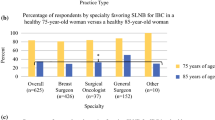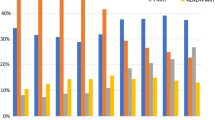Abstract
Introduction
Controversy over the need for sentinel node biopsy (SNB) continues to exist for the optimal treatment of breast cancer in patients ≥ 70 years of age, especially in those with lower-risk disease. Clinicians must balance competing risks to give the best individualized care.
Methods
The American Society of Breast Surgeons (ASBrS) conducted a debate discussing the pros and cons of routinely performing SNB in this age group. Small, randomized studies have been conducted that show no overall survival benefit to axillary intervention (either axillary dissection or SNB) in patients with clinically T1N0 estrogen receptor (ER)- and progesterone receptor (PR)-positive, HER2/neu-negative tumors. There may be a small local recurrence benefit to axillary staging in patients who do not undergo radiation. Alternatively, axillary ultrasound, which carries a low false-negative rate for heavy disease burden, can be used to select patients who can avoid SNB.
Conclusion
Surgeons must continue to individualize care of breast cancer patients over 70 years of age in whom competing comorbidities may dictate care. No randomized clinical trials (RCTs) have found a survival benefit to axillary staging in this low-risk population. However, in healthy patients, axillary staging may improve local control, provide prognostic information, and help guide decisions regarding adjuvant therapy such as chemotherapy and radiation. Ongoing RCTs are evaluating the benefit of SNB in patients with a negative axillary ultrasound. Until those results are available, clinicians and patients must balance the risk and benefits to determine if SNB adds significant value to their overall care.
Similar content being viewed by others
References
Centers for Disease Control and Prevention. https://www.cdc.gov/cancer/breast/2018.
American Cancer Society. Breast Cancer Facts & Figures 2017–2018. Atlanta: American Cancer Society. 2017. https://www.cancer.org/content/dam/cancer-org/research/cancer-facts-and-statistics/breast-cancer-facts-and-figures/breast-cancer-facts-and-figures-2017-2018.pdf.
Social Security Administration. Life Expectancy Calculator. https://www.ssa.gov/cgi-bin/longevity.cgi.
Welsh JL, Hoskin TL, Day CN, Habermann EB, Goetz MP, Boughey JC. Predicting nodal positivity in women 70 years of age and older with hormone receptor-positive breast cancer to aid incorporation of a society of surgical oncology choosing wisely guideline into clinical practice. Ann Surg Oncol. 2017;24(10):2881–2888.
Boughey JC, Hoskin TL, Welsh JL, Day CN, Goetz MP, Haffty BG, et al. Using size and grade to identify women aged ≥ 70 years with endocrine-responsive breast cancer at low risk of nodal positivity: Letter to Editor Reply to “Sized influences nodal status in women aged ≥ 70 with endocrine responsive breast cancer” by Fitzal, Florian et al. in Ann Surg Oncol. Ann Surg Oncol. 2017;24(Suppl 3):557–558. https://doi.org/10.1245/s10434-017-6156-0.
Schwartzberg LS, Blair SL. Strategies for the management of early-stage breast cancer in older women. J Natl Compr Cancer Netw. 2016;14(5 Suppl):647–650.
Weiss A, Noorbakhsh A, Tokin C, Chang D, Blair SL. Hormone receptor-negative breast cancer: undertreatment of patients over 80. Ann Surg Oncol. 2013;20(10):3274–3278.
Grumpelt AM, Ignatov A, Tchaikovski SN, Burger E, Costa SD, Eggemann H. Tumor characteristics and therapy of elderly patients with breast cancer. J Cancer Res Clin Oncol. 2016;142(5):1109–1116.
Mamtani A, Gonzalez JJ, Neo D, Slanetz PJ, Houlihan MJ, Herold CI, et al. Early-stage breast cancer in the octogenarian: tumor characteristics, treatment choices, and clinical outcomes. Ann Surg Oncol. 2016;23(10):3371–3378.
Diab SG, Elledge RM, Clark GM. Tumor characteristics and clinical outcome of elderly women with breast cancer. J Natl Cancer Inst. 2000;92(7):550–556.
Wyld L, Garg DK, Kumar ID, Brown H, Reed MW. Stage and treatment variation with age in postmenopausal women with breast cancer: compliance with guidelines. Br J Cancer. 2004;90(8):1486–1491.
van de Water W, Markopoulos C, van de Velde CJ, Seynaeve C, Hasenburg A, Rea D, et al. Association between age at diagnosis and disease-specific mortality among postmenopausal women with hormone receptor-positive breast cancer. JAMA. 2012;307(6):590–597.
Golledge J, Wiggins JE, Callam MJ. Age-related variation in the treatment and outcomes of patients with breast carcinoma. Cancer. 2000;88(2):369–374.
Yood MU, Owusu C, Buist DS, Geiger AM, Field TS, Thwin SS, et al. Mortality impact of less-than-standard therapy in older breast cancer patients. J Am Coll Surg. 2008;206(1):66–75.
Cortadellas T, Gascon A, Cordoba O, Rabasa J, Rodriguez R, Espinosa-Bravo M, et al. Surgery improves breast cancer-specific survival in octogenarians with early-stage breast cancer. Int J Surg. 2013;11(7):554–557.
Bouchardy C, Rapiti E, Fioretta G, Laissue P, Neyroud-Caspar I, Schafer P, et al. Undertreatment strongly decreases prognosis of breast cancer in elderly women. J Clin Oncol. 2003;21(19):3580–3587.
Hamaker ME, Schreurs WH, Uppelschoten JM, Smorenburg CH. Breast cancer in the elderly: retrospective study on diagnosis and treatment according to national guidelines. Breast J. 2009;15(1):26–33.
Angarita FA, Chesney T, Elser C, Mulligan AM, McCready DR, Escallon J. Treatment patterns of elderly breast cancer patients at two Canadian cancer centres. Eur J Surg Oncol. 2015;41(5):625–634.
Joerger M, Thurlimann B, Savidan A, Frick H, Rageth C, Lutolf U, et al. Treatment of breast cancer in the elderly: a prospective, population-based Swiss study. J Geriatr Oncol. 2013;4(1):39–47.
Jensen JD, Cold S, Nielsen MH, Jylling AM, Soe KL, Larsen LB, Ewertz M, Academy of Geriatric Cancer Research. Trends in breast cancer in the elderly in Denmark, 1980–2012. Acta Oncol. 2016;55(Suppl 1):59–64.
Evron E, Goldberg H, Kuzmin A, Gutman R, Rizel S, Sella A, et al. Breast cancer in octogenarians. Cancer. 2006;106(8):1664–1668.
Chagpar AB, Hatzis C, Pusztai L, DiGiovanna MP, Moran M, Mougalian S, et al. Association of LN evaluation with survival in women aged 70 years or older with clinically node-negative hormone receptor positive breast cancer. Ann Surg Oncol. 2017;24(10):3073–3081.
Fisher B, Jeong JH, Anderson S, Bryant J, Fisher ER, Wolmark N. Twenty-five-year follow-up of a randomized trial comparing radical mastectomy, total mastectomy, and total mastectomy followed by irradiation. N Engl J Med. 2002;347(8):567–575.
Lucci A, McCall LM, Beitsch PD, Whitworth PW, Reintgen DS, Blumencranz PW, et al. Surgical complications associated with sentinel lymph node dissection (SLND) plus axillary lymph node dissection compared with SLND alone in the American College of Surgeons Oncology Group Trial Z0011. J Clin Oncol. 2007;25(24):3657–3663.
Donker M, van Tienhoven G, Straver ME, Meijnen P, van de Velde CJ, Mansel RE, et al. Radiotherapy or surgery of the axilla after a positive sentinel node in breast cancer (EORTC 10981-22023 AMAROS): a randomised, multicentre, open-label, phase 3 non-inferiority trial. Lancet Oncol. 2014;15(12):1303–1310.
Hughes KS, Schnaper LA, Bellon JR, Cirrincione CT, Berry DA, McCormick B, et al. Lumpectomy plus tamoxifen with or without irradiation in women age 70 years or older with early breast cancer: long-term follow-up of CALGB 9343. J Clin Oncol. 2013;31(19):2382–2387.
Martelli G, Boracchi P, Ardoino I, Lozza L, Bohm S, Vetrella G, et al. Axillary dissection versus no axillary dissection in older patients with T1N0 breast cancer: 15-year results of a randomized controlled trial. Ann Surg. 2012;256(6):920–924.
Palta M, Palta P, Bhavsar NA, Horton JK, Blitzblau RC. The use of adjuvant radiotherapy in elderly patients with early-stage breast cancer: changes in practice patterns after publication of Cancer and Leukemia Group B 9343. Cancer. 2015;121(2):188–193.
Giordano SH. Radiotherapy in older women with low-risk breast cancer: why did practice not change? J Clin Oncol. 2012;30(14):1577–1578.
Ravdin PM, Siminoff IA, Harvey JA. Survey of breast cancer patients concerning their knowledge and expectations of adjuvant therapy. J Clin Oncol. 1998;16(2):515–521.
Daidone MG, Coradini D, Martelli G, Veneroni S. Primary breast cancer in elderly women: biological profile and relation with clinical outcome. Crit Rev Oncol Hematol. 2003;45(3):313–325.
Houssami N, Ciatto S, Turner RM, Cody HS 3rd, Macaskill P. Preoperative ultrasound guided needle biopsy of axillary nodes in invasive breast cancer: meta-analysis of its accuracy and utility in staging the axilla. Ann Surg. 2011;254(2):243–251.
Neal CH, Daly CP, Nees AV, Helvie MA. Can preoperative axillary US help exclude N2 and N3 metastatic breast cancer? Radiology. 2010;257(2):335–341.
Abe H, Schacht D, Sennett CA, Newstead GM, Schmidt RA. Utility of preoperative ultrasound for predicting pN2 or higher stage axillary lymph node involvement in patients with newly diagnosed breast cancer. AJR Am J Roentgenol. 2013;200(3):696–702.
Jackson RS, Mylander C, Rosman M, Andrade R, Sawyer K, Sanders T, et al. Normal axillary ultrasound excludes heavy nodal disease burden in patients with breast cancer. Ann Surg Oncol. 2015;22(10):3289–3295.
van Roozendaal LM, Schipper RJ, Van de Vijver KK, Haekens CM, Lobbes MB, Tjan-Heijnen VC, et al. The impact of the pathological lymph node status on adjuvant systemic treatment recommendations in clinically node negative breast cancer patients. Breast Cancer Res Treat. 2014;143(3):469–476.
Tucker NS, Cyr AE, Ademuyiwa FO, Tabchy A, George K, Sharma PK, et al. Axillary ultrasound accurately excludes clinically significant lymph node disease in patients with early stage breast cancer. Ann Surg. 2016;264(6):1098–1102.
Gradishar WJ, Anderson BO, Balassanian R, Blair SL, Burstein HJ, Cyr A, et al. NCCN Guidelines insights: breast cancer, Version 1.2017. J Natl Compr Cancer Netw. 2017;15(4):433–451.
Fisher B, Anderson S, Bryant J, Margolese RG, Deutsch M, Fisher ER, et al. Twenty-year follow-up of a randomized trial comparing total mastectomy, lumpectomy, and lumpectomy plus irradiation for the treatment of invasive breast cancer. N Engl J Med. 2002;347(16):1233–1241.
Cyr AE, Tucker N, Ademuyiwa F, Margenthaler JA, Aft RL, Eberlein TJ, et al. Successful completion of the pilot phase of a randomized controlled trial comparing sentinel lymph node biopsy to no further axillary staging in patients with clinical T1–T2 N0 breast cancer and normal axillary ultrasound. J Am Coll Surg. 2016;223(2):399–407.
Gentilini O, Veronesi U. Abandoning sentinel lymph node biopsy in early breast cancer? A new trial in progress at the European Institute of Oncology of Milan (SOUND: Sentinel node vs Observation after axillary UltraSouND). Breast. 2012;21(5):678–681.
Acknowledgment
Lorraine Tafra would like to thank her team of breast surgeons for their wise counsel and generous sharing of their experiences and expertise.
Author information
Authors and Affiliations
Corresponding author
Rights and permissions
About this article
Cite this article
Blair, S.L., Tsai, C. & Tafra, L. ASBRS Great Debate: Sentinel Node Biopsy in Patients Over 70 Years of Age. Ann Surg Oncol 25, 2813–2817 (2018). https://doi.org/10.1245/s10434-018-6617-0
Received:
Published:
Issue Date:
DOI: https://doi.org/10.1245/s10434-018-6617-0




